ENERGY
Power over Ethernet solutions market growth to be influenced by rising commercial smart buildings
The global PoE solutions market share is on the rise, a trend that is expected to continue over 2019-2025. PoE solutions industry outlook will be augmented by widespread adoption of VoIP solutions, IP cameras, smart office buildings, access control systems etc. PoE solutions are estimated to make huge strides in various sectors owing to the new wave of technology and digital advancements that are transforming security operations.
APAC Power over Ethernet (PoE) Solutions Market Share, By Region, 2018
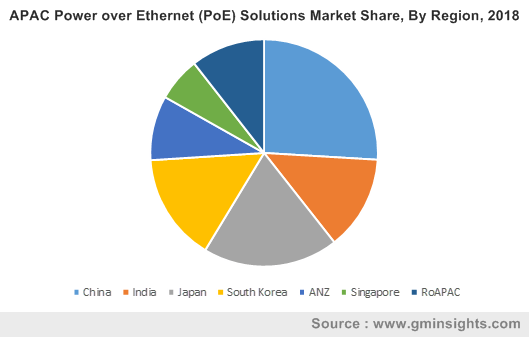
The healthcare ecosystem is increasingly coming to include smart technologies that will significantly contribute to Power over Ethernet solutions market growth in the forecast years. For instance, use of IP cameras in the hospitals and healthcare facilities is anticipated to become ubiquitous in the times to come. Hospitals have started deploying IP cameras to monitor when a patient sits up in bed, gets out of bed, or is tossing and turning in a restless effort to get to sleep. These cameras have enhanced patient care to a greater extent. Use of IP cameras has been growing in hospitals to observe high risk patients efficiently. Adoption of IP cameras will in turn augment PoE solutions market outlook in the coming years.
Another utilitarian device which will supplement growth of PoE solutions industry is increasing use of VoIP phones. By deploying VoIP phones, enterprises have been incessantly improving communication and collaborations among employees and remote users to increase business productivity. Leveraging the benefits of converged voice and data services, companies have enhanced their performance and communication. The convergence of unified communication services and enterprise VoIP to enable video-conferencing, live-chat, and other calling capabilities is expected to fuel VoIP market size and invariably expand PoE solutions industry trends.
Get a Sample Copy of this Report:@ https://www.gminsights.com/request-sample/detail/3346
Several technology companies have been toiling to develop PoE solutions and devices to support innovation. For instance, IP-COM has reportedly rolled out the G3210P, an 8-Port gigabit PoE switch with 2-Port SFP. The G3210P has been designed independently to satisfy the need of building a high-performance Gigabit Ethernet network. It can source electricity to high-power PDs and also can transmit data and supply electricity at the same time to IP Phone or IP Camera, AP via Cat.5e twisted-pair cables. Companies launching such devices in the market will remarkably contribute to foster PoE industry share by 2025.
Proliferation of Internet of Things (IoT) is among major drivers that will lead to PoE solutions market size expansion in the coming years. Adoption of IoT among enterprises has increased rapidly to support advancements in business infrastructure. Around 85 percent of organizations who acquire deep expertise with IoT have succeeded in propelling revenue share faster than rivals.
Nearly 68% of enterprises are using IoT to track security of physical assets, making this use case the most common across enterprises today. Approximately, 34% of global businesses are using IoT in daily operations, up from 29% in 2018, with 95% of IoT adopters already recording appreciable benefits. Rapid deployment of IoT among organizations is going to considerably increase PoE solutions market share as PoE has the potential to power the network ecosystem of the future that will enable global digital transformation.
Businesses have also increased focus on infrastructure security to protect sensitive data. Office spaces these days are being equipped with various security systems that require considerable investments. For instance, Euromicron AG has reportedly secured the contract for a major building technology project worth €3.6 million. The building will be completely equipped with access control. Transponder readers will be installed at all entrances and doors on floors, at the entrances to stairways, in the underground car park and basement, and at the doors to the IT technical rooms. PoE solutions industry outlook will be positively influenced by the rising deployment of security and access control systems throughout technologically advanced office spaces.
Smart lighting is yet another feature that is being widely integrated into the smart buildings of tomorrow. Typically, lighting is responsible for 40 percent of a building’s electricity use. To develop smart office spaces with minimal electricity use, smart lighting industry players have been striving to adopt various strategies.
For instance, in the year 2015, Philips and Cisco had announced a global strategic alliance to create new value in energy savings, building efficiency and employee productivity by promoting connected lighting system. Both the companies had intended to deliver a consistent PoE-powered LED lighting solution utilizing a highly secure IT network. Close to 80% in energy savings and decreased building maintenance expenses can be achieved by operating, integrating and regulating a Philips LED connected lighting system via a network with Cisco. Instances of such efforts are in plenty and are anticipated to propel Power over Ethernet solutions market share.
Significantly, commercial sector has contributed to a market share of nearly 30% to PoE solutions industry in 2018 and the trend of integrating smart solution will help to maintain similar growth patterns over 2019-2025.
With growing adoption of smart solutions in office and commercial space, PoE solutions will be much in demand for enabling these smart solutions. Global Market Insights, Inc., has estimated that global PoE solutions market share is anticipated to exceed $2 billion by 2025.
Author Name : Anchal Solanki
North America micro data center market to record double-digit CAGR over 2019-2025
The global micro data center market will witness immense growth in the years to come due to rapid technological advancements in the IT & telecom sector which has led to expansion in data center infrastructures worldwide. As online banking & shopping, satellite navigation systems, smartphones, TV & movie streaming gain traction, relocation of IT infrastructure becomes mandatory. This increases the demand for modular data center architecture that will drive the global micro data center market size.
U.S. micro data center market, by application, 2018 & 2025 (USD Million)
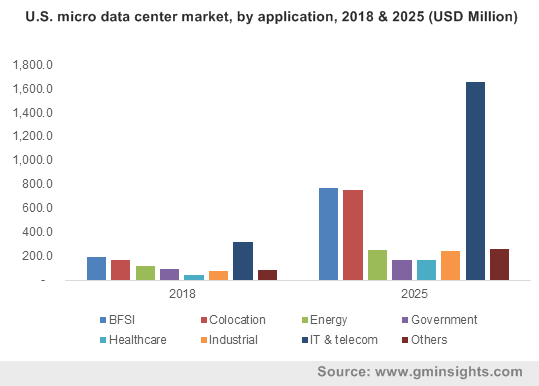
The rising need for containerized data centers for corporate offices that consistently relocate their infrastructure will fuel micro data center industry share. With rising workloads, companies are focusing more on data center expansion. However, enterprises are now wanting to make their presence felt on the cloud, leading to the requirement of portable data centers. Micro data centers have a smaller footprint that conventional data centers and look like with integrated systems. The rising requirement for portable solutions in large-scale enterprises for delivering additional IT support will drive micro data center market size.
The healthcare sector will be a major application segment of micro data center industry. Medical care centers demand efficient power systems for consistent access to patient electronic health records. The rise in the number of chronic diseases and patient admissions can sometimes though, put pressure on hospitals, emergency clinics and rehabilitation centers since conventional data center infrastructure requires a huge investment. But miniaturized, portable data centers eliminate a lot of the up-front investment and are being preferred by medical care facilities, that will drive micro data center market size from hospitals.
Get a Sample Copy of this Report:@ https://www.gminsights.com/request-sample/detail/2762
North America micro data center market will grow significantly over 2019-2025 driven by robust urbanization and digitization trends. The presence of major multinational companies planning on expanding their operational capacities in the U.S. will drive the North America industry. Most huge enterprises in the U.S. require efficient IT infrastructure for business management. The rising need of huge companies and SMBs for portable solutions will fuel the regional micro data center industry share.
Global Market Insights, Inc., estimates the North America micro data centers market size to register a CAGR of more than 23% over 2019-2025. The growth is driven by the launch of various micro facilities by important technology giants such as Schneider and IBM Corporation. The expansion of data center infrastructure market in the region will also propel North America micro data center industry share.
Prominent industry giants are consistently making investments in portable data center solutions to cater to rising demand from hospitals, IT companies, telecom firms, banking establishments, etc. For example, in March 2019, Schneider Electric had declared the launch of new solutions for micro data centers which combine APC by Schneider’s physical infrastructure with Cisco’s HyperFlex Edge that delivers efficient, fast deployment in edge environments.
Cisco and Schneider Electric’s latest partnership on micro data centers will provide system integrators and IT global channel partners the access to new reference designs for deploying the HyperFlex Edge that can be suitably customized for particular micro data center needs. The rising demand for pre-integrated, physically secure, and remotely monitorable containerized data center solutions and increasing efforts by industry players to provide these services will drive the global micro data center market size.
Some of the other players defining the competitive landscape of micro data center include Advanced Facilities, Inc., Zellabox, Schneider Electric SE, Attom Technology, Eaton Corporation PLC, Panduit Corporation, Delta Power Solutions, Canovate Group, Dataracks, Hewlett-Packard Enterprise Company, STULZ GmbH, Huawei Technologies Co., Ltd., IBM Corporation, Dell Inc., and Vertiv Co.
Companies partaking in micro data center industry share are trying to enhance their presence by coming up with new, more efficient portable data center solutions. Delta Power Solutions has a product portfolio of the Delta InfraSuite – a highly integrated, next-gen modular datacenter solution that uses racks and integrates cooling, lightning protection, wiring, fire control, UPSs, and airflow management together.
Global Market Insights, Inc., claims the overall micro data center market size to cross USD 14.5 billion by 2025.
Author Name : Saipriya Iyer
Modular data center market to register commendable proceeds from IT & Telecom applications, increasing adoption of IoT and edge computing to drive product demand over 2019-2025
The global modular data center market is poised to gain massive impetus in the ensuing years, primarily driven by the increasing adoption of prefabricated IT technologies, the emergence of small & medium enterprises and the rising demand for edge computing.
The demand for edge computing is rising owing to the massive shifts in the way internet is consumed via organizations and individuals. Edge computing is an architecture that enables data processing and computing as close to the end user as possible. The key drivers of the edge computing model include the growing number of consumer mobile devices and the increasing consumption of video and virtual reality content. Eminent players active in the modular data center industry are seeking innovative ways of deploying edge capacity to support end-users including businesses and consumers. Therefore, as the popularity of edge computing grows across several applications, the global modular data center market size is certain to escalate as far as the number of installations is concerned.
U.S. modular data center market, by application, 2018 & 2024 (USD Million)
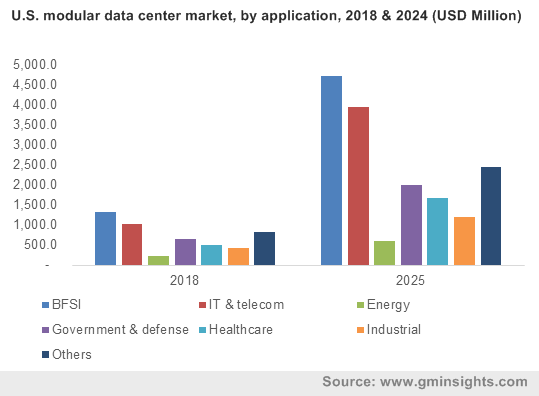
The modular data center market from IT & Telecom application segment is primarily driven by the rising need for the rapid deployment of data centers. IT & telecom business vertical is witnessing a massive adoption of the facility to augment the flexibility and scalability of the business operations. Another factor that is driving the modular data center market is the rapid evolution of IoT technology. With the adoption of IoT sensors, the technology is being used in a wide spectrum of applications, for procuring data from the surrounding environment.
The increasing need for data storage would require more robust load distribution strategies. The burgeoning IoT trend will spur the need for edge computing, which will positively impact the demand for IT infrastructure that is easily deployable in remote locations and cost-effective. Hence, the increasing the need for data storage and processing from IT & Telecom application segment will require more data centers to handle diverse and huge data flows, thereby driving the global modular data center market expansion in the future.
Get a Sample Copy of this Report:@ https://www.gminsights.com/request-sample/detail/1730
SMEs are significant to economies, particularly the developing ones, but they seldom have access to sufficient credit. According to the World Bank Group, around 70% of all micro, small, and medium scale businesses in emerging markets lack access to credit. As modular data centers can do everything, right from computing, storing, processing, cooling, securing, and detecting fire, hence they can help organizations in saving significant infrastructure and setup costs. Which makes small and medium-sized enterprises a major customer base for this technology, thus allowing SMEs to deploy and maintain their IT operations with low capital expenditure but without compromising on quality. Having said that, the burgeoning number of SMEs in emerging economies will thus be a major factor responsible for propelling the global modular data center industry.
The competitive landscape of the global modular data center industry hosts numerous well-known players such as Cisco Systems, Inc., Huawei Technologies, Cannon Technologies, and Dell, Inc. among others. In order to enhance and expand business operations, major players often engage in partnerships and develop innovative technologies, thereby increasing the revenue inflow of the global market. An ideal example involves Huawei’s recent partnership with Etisalat to plan and distribute pre-fabricated and next-gen modular data centers in UAE in an effort to suffice the requirements of the cloud and digital services of the future. Such partnerships will fulfill the product demand across diverse geographies and hence contribute to the expansion of the global modular data center market.
Additionally, growing applications fueled by innovations in the fields of retail, telecom, and finance along with the emergence of 5G technology will further advance the modular data center market growth. All in all, consumer reliance on the digital world is growing every minute and with increasing adoption of digitized platforms and technologies, data traffic will continue to grow, boosting the requirement for modular data centers globally. A research report by Global Market Insights, Inc. projects the overall modular data center market to be worth more than $50 billion by 2025.
Author Name : Krithika Krishnan
Non-Destructive Testing (NDT) Service Market to garner lucrative proceeds from ultrasonic inspection technology segment over 2019-2025, Europe to emerge as a leading terrain for industry expansion
The commercialization potential of non-destructive testing (NDT) service market is set to witness renewed momentum owing to the evolving demands of the global industrial sector and the effect of digital transformation. These services are anticipated to reach a wider range of business verticals due to the rising number of disruptive innovations and the emergence of pathbreaking technologies such as AI and IoT.
U.S. Non-Destructive Testing (NDT) Service Market Revenue, By Method, 2018 & 2025
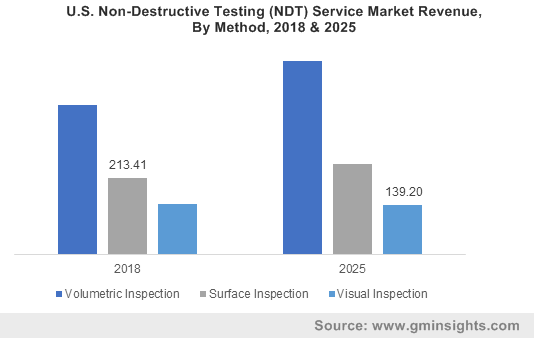
Enhancements in the ultrasonic inspection technology to boost the remuneration scale of NDT service industry
Worldwide, assets of various business verticals are aging and the number of inspection regimes has witnessed an unprecedented uptick as safeguarding these assets is turning out to be a tough task. Invariably, the demand for agile inspection equipment has been intensifying lately. In this context, it is quite imperative to state that ultrasonic inspection testing is being regarded as one of the most prominent technology types among all the NDT services. Some recent developments associated with the improvement of the NDT services – utilizing high-end technologies and research – are set to not only enhance the productivity levels but also add stealth to the ultrasonic inspection testing. Enumerated below are a few major instances that are a testimony to the significant research activities and increasing product ingenuity:
- Material testing services provider Element has recently launched a new testing lab spread across 20,700 square foot in Sheffield, United Kingdom. The new lab, which would be a prominent part of the undergoing industrial revolution in the region, will be situated close to Advanced Manufacturing Innovation District of Sheffield. It would be a center for excellence for NDT and inspection research and would prove advantageous to the consumers from the oil and gas and aviation sectors. Additionally, its location would ensure that it receives access to latest technical expertise and support, essentially propelling the growth prospects of NDT services market in the region.
- Manufactured for a wide range of applications spanning from a flat plate to a tiny 50 mm diameter surface, Silverwing R-Scan is a new handheld portable B-Scan inspection system which aims to improve the probability of detection and data quality of ultrasonic inspections. Introduced by Eddyfi Technologies, the new NDT solution can be used to complete tank inspections where an automated and remote crawler such as the scropion2 system cannot be deployed. The registered information sets are displayed in a cross-sectional B-scan view that assists in improving in-service flaws, reveal corrosion, increasing speed, and the inspection quality. Remarkably, the addition of such agile, advanced, and portable inspection systems to the product range of ultrasonic inspection testing providers would boost the overall geographical reach of NDT service market.
Get a Sample Copy of this Report @ https://www.gminsights.com/request-sample/detail/3201
Europe to contribute massively toward strengthening the revenue profile of the global NDT service industry
Speaking of the growth of the NDT service industry in geographical terms, Europe held more than 30 percent of the revenue share of this business vertical in the year 2018. Presence of numerous well-known companies such as Bureau Veritas, SGS, and Intertek in the region has been a crucial factor in reaching out to a large customer base. In addition to this, stringent regulatory guidelines – rolled out by European Union along with various local governments – mandating the usage of NDT services to ensure product and employee safety has assisted the industry players to reach high potential growth areas.
Elaborating further on the leading position of Europe, it has also helped that the region’s aviation sector is on a roll with a clearance of a massive backlog of aircraft orders being concluded recently. To put things in perspective, prominent aircraft manufacturers such as Airbus and Boeing have a record backlog of more than 12,000 new aircraft that are to be manufactured by the year 2025, creating humongous growth opportunities for the Europe NDT service market in the forthcoming years.
Considering the humble beginnings of the NDT service industry, it is prudent to mention that drastic enhancements over the years have increased the usage of these services across numerous applications. This growth trajectory of the NDT service market is certain to continue in the coming years, as has been highlighted in the research report compiled by Global Market Insights, Inc. which claims that this business vertical would surpass a decent remuneration scale of about USD 4.5 billion by 2025.
Author Name : Saif Ali Bepari
Global structured cabling market remuneration to hit USD 25 billion by 2025, escalating product demand from data center facilities to fuel the industry landscape
Propelled by extensive proliferation of digitization, the structured cabling market is slated to establish itself as an extremely lucrative investment ground in the forthcoming years. A number of legacy facilities are finding it difficult to maintain the order & ease with which a cabling infrastructure can be accessed. However, the extensively used cable management solutions & products in structured cabling can be installed with relative ease & can facilitate modular and simple designs, providing these legacy facilities with an ideal solution for the challenges they face, thereby driving the structured cabling market landscape.
U.S. structured cabling market, by application, 2018 & 2025 (USD Million)
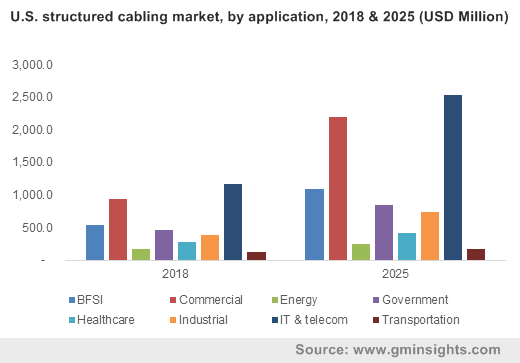
Apart from industrial applications, structured cabling is also finding deployment in modern residential & commercial construction projects. One of the latest avenues of growth for the market is the rapidly developing smart building & intelligent lighting industry, fraught with LED lights, integrated with sensors & controls that perform a number of different tasks, ranging from motion sensitive lighting and controlling brightness & color through the smartphone to managing ventilation according to the number of individuals in a room.
Global structured cabling market | Impact of the growing data center demands from businesses
The increasing adoption of several digital services as well as the growing population of internet users has been augmenting data center demands across the world, which is in turn fueling structured cabling market growth. The world is becoming increasingly more digital & connected – indeed, according to a Cisco Visual Networking Index, the annual IP traffic across the world would be reaching the 3.3 zettabytes (ZB) mark by year 2021 and would be increasing more than threefold over the coming five years, driving extensive demand for data centers.
Structured cabling systems are a crucial part of data centers as they facilitate faster data-transfer rates and ensure effective connectivity of the different IT devices in the facility, thus lessening the chances of system failure & downtime, which significantly improve the effectiveness of a business’ decision-making process, helping it maximize its profits.
Get a Sample Copy of this Report@ https://www.gminsights.com/request-sample/detail/3125
Moreover, increasing high-speed connectivity demands of data center & device convergence would also be responsible for driving the market’s growth. The industry is witnessing an increasing rate of adoption of coaxial & fiber optic cables to quench the high-speed connectivity demands. These cables boast of a significantly greater level of bandwidth & can transfer much larger amounts of data per unit of time in comparison to conventional metal cables, making them a must-have for modern networks and thereby driving structured cabling market further.
Global structured cabling market | Impact of the IT & Telecom sector’s growing dependence on structured cabling
With increasing demand for faster connectivity & higher bandwidth, network designers are of the opinion that the fiber-optic structured cabling segment would be establishing itself as a backbone for the global telecom industry infrastructure. The modern technology-driven world has been changing the operating demands of almost all of the industrial sectors. Moreover, with the rapid evolution of smart devices such as tablets, smartphones & smart watches, that consume voice & data services on a regular basis, the integration of IT & telecommunication is getting rather advanced. This amalgamation is expected to drive more standardization in the two industries during the implementation of advanced technologies & infrastructures that enhance the voice & data services. This has put an increased amount of pressure on telecom companies to facilitate uninterrupted & better services to their customers.
The fiber-optic structured cabling solution is being termed an ideal way with which the industry can fulfil its connectivity requirements as they provide an optimal environment that can transmit voice & data at extremely high speeds. Moreover, as data centers are telecom operators’ foundation in present scenario, the upgradation of these facilities to enhance user experience would also be driving the structured cabling industry size from the IT & telecom sector.
Furthermore, according to a 2018 report by TeleAnalysis, adapting to changing circumstances, more than 60% of the world’s telecommunication network facilities are projected to become data centers over forthcoming years, enabling the structured cabling market to depict sizable growth from the IT & telecom applications.
Owing to the presence of a connectivity-driven foreground, the global structured cabling market would be drawing in significant growth over the years to come. In fact, according to a research report by Global Market Insights, Inc., the overall structured cabling market size would be exceeding a valuation of $25 billion by 2025.
Author Name : Akshay Kedari
Europe data center liquid cooling market to record extensive gains by 2025, robust adoption of direct immersion cooling solutions to expedite the industry landscape
The increasing demand for digital services and unprecedented growth in AI and machine learning has helped push data center liquid cooling market share to new heights lately. Data centers demand efficient cooling systems to reduce power consumption as over 30% of the power is used for cooling purposes. Processor performance is also severely affected by overheating resulting in slower operations. However, with businesses increasingly shifting towards mainframes and supercomputers, liquid cooling technology seems to be an ideal solution for modern data centers. Furthermore, the consistently changing demands for new, uninterrupted digital has been prompting data centers to adopt innovative technologies that will help boost data center liquid cooling market in the coming years.
China data center liquid cooling market, by solution, 2018 & 2025 (USD Million)
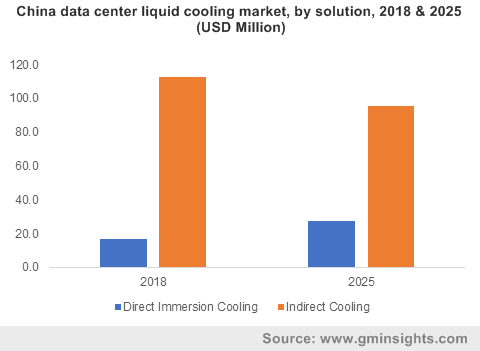
The growing implementation of artificial intelligence (AI), big data, cloud, and machine learning in newly developed software solutions has also been driving the industry growth. With the development of more powerful chips capable of rapidly processing data for new complex applications, the amount of power consumption has exponentially increased leading to more component heat generation. For instance, an increasing number of GPUs and FPGAs are nowadays pushing systems to their limits for smoothly running heavy applications like AI, big data analytics, HPC, media streaming, machine learning which in turn generate high amounts of heat. Reports claim that the heat profile for many GPU based servers is double than that of traditional servers. However, with the benefits of liquid cooling technology businesses can deploy applications at a much higher density with increased efficiency, that will lead to a commendably reduced carbon footprint, supplementing the data center liquid cooling industry growth in the upcoming years.
One of the most extensively used solutions for data center cooling is the direct immersion cooling solution. Also known as liquid submersion cooling, this solution is used to submerge full servers in a thermally conductive liquid to offer enhanced temperature control. The method is slowly gaining popularity with innovative datacenters across the world. Some ultra-high-speed supercomputers like IBM’s Summit supercomputer already use liquid cooling technology to pump around 4,000 gallons of water per minute through its system.
Get a Sample Copy of this Report @ https://www.gminsights.com/request-sample/detail/3090
Direct immersion can significantly cool solid-state drives, which makes the entire process more efficient in comparison with traditional methods. The technology also reduces system humidity & heating effect, further offering high operational performance and speed. Additionally, solution developers offer efficient maintenance & installation services to data center clients which further supports industry expansion. Indeed, it comes as no surprise that the data center liquid cooling industry will gain substantial momentum from the robust adoption of direct immersion cooling solutions.
Hyperscale data centers – the latest trend that will proliferate data center liquid cooling market size
The increased focus on business agility and cost optimization has led to the rise and growth of cloud data centers which in turn has given birth to the trend of hyper scaling. Hyperscale cloud operators are increasingly offering better resources and bandwidth that support the growing demand for storing large chunks of data on the cloud. Compared to traditional models, hyperscale data centers require to operate in colder zones as these facilities constantly handle increasingly large amount data traffic, which expands IP connections and fulfills high storage demands, factors that make it essential for deploying servers with high-density cooling elements like liquid coolers and water-chilled metal boxes equipped with blowers to enable fast operation at ambient temperatures. The growing shift towards hyper scale cloud data centers will thus augment the growth of data center liquid cooling industry.
Speaking of the regional expanse of the data center liquid cooling market, it would be prudent to state that APAC and Europe are two prominent geographical revenue pockets for the industry. Asia Pacific data center liquid cooling market will witness significant growth over the ensuing years, driven by the increase in data capabilities brought forth by the growing digitalization in every possible industry sector.
The expansion of the Europe data center liquid cooling market can be majorly credited to the massive presence of numerous colocation facilities across the continent. Powered by the advent of robust digitization across the industries such as BFSI and medical care, in tandem with the rapid adoption of machine learning technology in the region, Europe data center liquid cooling industry share is set to soar high in the years to come.
Liquid-based cooling solutions have more heat removal capabilities & can reduce a data center’s power consumption by about 70%. The paradigm shift toward high energy consuming applications and the deployment of AI, big data and machine learning will mandate the adoption of liquid cooling solutions for smoother operations in the years ahead. Reports from Global Market Insights, Inc. cite that the data center liquid cooling market size will exceed the $2.5 billion mark by 2025.
Author Name : Mateen Dalal
Proliferation of cooling solutions to bolster edge data center market size by 2025
The massive penetration of 5G technology and IoT worldwide has led the global edge data center market to observe phenomenal gains during the span of seven years starting from 2019-2025. As is proclaimed, the expansive commercialization of 5G technology has provided a positive outlook to edge data center industry.
Apparently, the edge data centers enable processing of humongous volumes of data in juxtaposition to the base stations in 5G infrastructure. This has prompted the service providers to translocate the facilities to manage and bring about an ease in the on-premises edge infrastructure.
The robust proliferation of myriad applications spanning, autonomous vehicles, precision agriculture, immersive entertainment, and augmented reality, is likely to compel the industry giants to indulge in the development of edge facilities leading to high growth prospects for the edge data center industry over the forecast period. A testament to this can be provided by EdgeConneX, Inc., which developed MicroEdge data centers across 1,000 locations worldwide in order to support the future generation 5G-dependent applications.
It has been apprehended that the edge data centers overcome irregular connections, minimize the inactivity, and compute data close to the users. Moreover, these benefits are leading to a hefty construction of the centers in remote locations.
According to the market speculations put forward by Global Market Insights, Inc., the worldwide edge data center market size is likely to cross a mammoth of USD 16 billion by the end of 2025.
Get a Sample Copy of this Report:@ https://www.gminsights.com/request-sample/detail/2421
Encompassing a huge component spectrum, the cooling solutions segment is expected to hold a substantial revenue share in the overall edge data center market. This can be ascribed to the ongoing demands for reduced operational costs and augmented data center performance. Estimates claim that the edge data center solutions help in combating the damages to the systems and processors by restricting excessive heat from the infrastructure. Along with heat management, the cooling solutions also maintain a balanced temperature and control the humidity levels across the facilities.
The product manufacturers across the world are offering novel cooling techniques to promote highly efficient and economic power and energy consumption whilst reducing the environmental impacts.
Having procured a commendable share in the global edge data center market, the BSFI sector is witnessing robust demand for edge facilities ascribing to the necessity of compactly managing a massive amount of consumer data.
Reliable sources claim that the financial industry contenders are, on a large scale, deploying the data center facilities to accomplish several advancements and modifications in the proximity of their operational centers. This would help the organization to reduce the risk of data breaches and speed up the disaster detection and prevention in the near future.
Considering the geographical aspects, mounting penetration of OTT providers and telecom operators across the Asia Pacific region would boost the regional industry dynamics over the projected time frame.
The enterprises are exceedingly investing in the upgradation of the data center infrastructures across the emerging economies in the APAC region including India, China, and Japan. This is predicted to establish tremendous growth opportunities for the industry expansion and lead to the development of advanced data center facilities.
Furthermore, favorable initiatives undertaken by the various governments to support the development of all industrial sectors and support their respective nations would also apparently spur the market growth by the end of 2025.
The prominent market players across the edge data center industry include EdgeConneX, Inc., Hewlett-Packard Enterprise Company, IBM Corporation, Schneider Electric SA, and multiple others.
Author Name : Vinisha Joshi
Europe data center colocation market to observe noteworthy proceeds by 2025
A business space of high repute, thriving immensely on the increasing complexity of managing massive data centers, the global data center colocation market of late, stands as one of the most outpacing industry verticals of all times. Additionally, the advent of IoT coupled with rapid penetration of big data and cloud technologies have prompted various end-use sectors to focus on structuring the physical infrastructure of IT services. Apparently, the overall IT spending in 2018 grew by 3.8 per cent due to increased spending by the cloud providers.
Colocation is gaining massive traction across the globe, amidst the organizations, and is being adopted with an intent of reducing the expenses pertaining to the management and building of the data centers.
A paradigm shift towards the colocation hosting by large enterprises and SMEs calls for huge preliminary investments which will foster the revenue scale of data center colocation market during 2019-2025. As per the market speculations put forth by Global Market Insights, Inc., the worldwide data center colocation industry size is forecast to be pegged at USD 100 billion by the end of 2025.
Not to mention, data center colocation market would transform to become one of the most revolutionizing business spaces of the 21st century.
Considering the type spectrum, the retail colocation segment accounted for a significant business share in the data center colocation market perhaps owing to their provision of high security in a multi-tenant environment.
Get a Sample Copy of this Report:@ https://www.gminsights.com/request-sample/detail/2419
The construction and maintenance of data centers remains out of the question for the enterprises that have budgetary constraints. In this regard, the small and medium sized enterprises have planned to shift to data center colocation services to store ample amounts of data.
Having said that, the small enterprises end-user segment is likely to witness a commendable growth in the data center colocation industry in the upcoming years. Scalability being an alarming concern for these enterprises, the data colocation services provide them an ease in structuring and maintaining the fundamental resources. The data center colocation industry trends from the SMEs would also foresee a significant growth over the forecast period probably due to the high security provision, all-round customer support, robust reliability, and compliance management.
Data center colocation industry is driven by a vast application spectrum predominated by the IT and telecom sector which is claimed to register robust adoption of the data center services and develop at a prodigious pace over 2019-2025. The wide scale adoption across the sector is attributed to the burgeoning demands for the storage of humongous volumes of data. The escalating demands for enhancing the efficiency across the business operation has established new avenues for the industry players.
It is prudent to know that various industry players are involved in upgrading their services to cater to the industry sectors. In fact, China Telecom Americas Corporation declared offering disaster recovery and website hosting services on the grounds of managing massive amount of data generated.
Additionally, rising dependency on these services across the IT and telecom sectors will positively influence the data center colocation growth map over the years to come.
Strong foothold of major data colocation centers across Europe, led by Germany, UK, France, and Netherlands, is likely to surge the adoption of these facilities and impel the market trends over a span of seven years. For the record, Europe houses over 1,160 colocation centers which are widespread across 20 countries in the region.
In addition to this, various European countries like Italy, Spain, and Russia are recuperating from the economic crisis thereby paving way for the business to flourish across the countries. Concurrently, the robust presence of prominent data centers like Telehouse North, PA2, Paris Voltaire, and Telehouse East, have added an impetus to the regional growth.
Author Name : Vinisha Joshi
Private LTE market to procure extensive proceeds from the energy sector, surging product adoption by telecom service providers to stimulate the industry growth
The increasing importance imparted to network stability & wireless communication to speed up network capability has been stimulating private LTE market share. Nowadays, private LTE is used extensively for numerous beneficial purposes such as real-time monitoring, geo positioning activities, in the mobile devices, energy utilities, telecommunication applications, and automotive equipment. The rapid acceptance of long-term evolution (LTE) for high-speed wireless communication across numerous industrial sectors has been encouraging companies in private LTE market to adopt LTE network connectivity.
Europe Private LTE Market Revenue, By Infrastructure, 2017 & 2024 (USD Million)
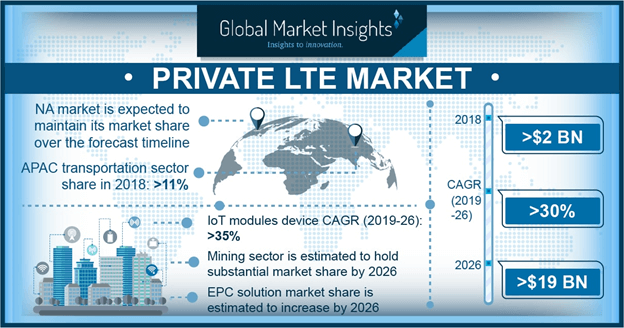
Over the last few years, most of the mobile network providers have shifted to LTE services from 2G and 3G coverage to improve existing communications. The surging digitalization and modernized mobile services have also substantially enhanced data services. Recently in India, the nation’s largest telecom company, Airtel has decided to switch to LTE network services to boost data speed. This move will turn out to be rather beneficial for Airtel as it already has a widespread, far-reaching network coverage. The shifting focus of telecom service providers to LTE to phase out older networks is slated to fuel private LTE industry share.
Taking into account the network benefits of high-speed data services, most of the energy companies have been signing deals with wireless network providers that will have a positive influence on the product demand. For instance, a month before, the Brazilian power distributor, Elektro collaborated with Nokia for deploying a private LTE network in its City of Atibaia based electric grid. The deployment of LTE services is slated to help improve the efficiency and reliability of the electric grid that has been serving approximately more than 75,000 business and homes. Through this network, it is also possible to operate smart meters, grid equipment, substation and distributed energy generation sources.
Get a Sample Copy of this Report:@ https://www.gminsights.com/request-sample/detail/2757
Such strategic deals will help players in the private LTE market strengthen their customer base and diversify the traditional telecommunication practices. The surging adoption of digital technologies such as IoT and machine learning will thus further propel the use of private LTE service in the energy sector. For the record, as per estimates of Global Market Insights, Inc., private LTE market from energy applications is slated to depict a commendable CAGR over 2018-2024.
In order to achieve a dominant stance in the market, telecom firm Nokia has also lately been adopting myriad business tactics. Recently, it has collaborated with China Unicom to deploy a private LTE network at BMW Brilliance Automotive Ltd plant based in the Liaoning province. With the use of private LTE connectivity, BMW can carry out smart manufacturing activities and ensure communication for critical applications including video surveillance, object tracking, and analytics at the plant.
The integration of private LTE network in the enterprises to secure data and voice communication, wireless video communication, ensure indoor investigation, and inspect the production line maintenance is slated to fuel the product demand over the years ahead. Heavy investments to develop digitalized, modern factories with a secured and transparent work culture will further propel private LTE market share considerably.
The emergence of LTE connectivity has also turned out to be rather useful for maintaining peace across the globe. That is to say, the UN (United Nations) has been working continuously to resolve the several global issues for which it has been using LTE network for providing critical communication capabilities. Peacekeeping troops are able to effectively use this LTE network for secure, stable, and future-proof broadband services while operating through the tough geographic terrain. Currently, UN is working on fourteen peacekeeping operations across the globe and it is planning to establish high-speed LTE networks by 2019 to accelerate the communication throughout the missions.
Substantive use of LTE connectivity for ensuring digital and standardized work output in the industrial as well as the defense sectors is likely to propel the product demand over the years ahead. On-going changes in the telecommunication technologies to enhance the network connectivity will further stimulate the industry trends. As per estimates, with the surging acceptance for network connectivity across various application sectors, private LTE market is poised to surpass a revenue collection of USD 11 billion by the end of 2024.
Author Name : Sunil Hebbalkar
